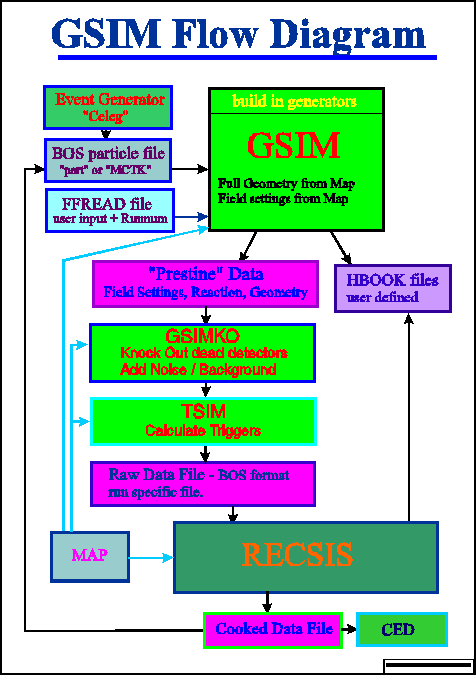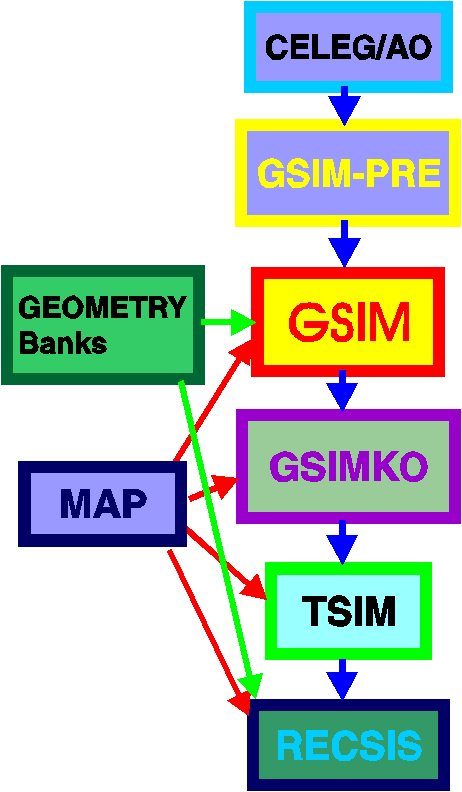GSIM Overview
 Click on image to get GIF file twice this size.
Click on image to get GIF file twice this size.
GSIM Flowchart Descriptions
 The Chain of GSIM analysis starts with an
event generator such as Celeg or an AO based
generator. If you write our own generator it is
best to write it as a standalone code instead of
building it into the GSIM user code.
.
.
The next program in the chain, GSIM-PRE, is
optional. This code filters out those particle tracks
that would normally only hit a Torus coil, beam
pipe or other structure.
.
.
.
Most of the cpu time will be spend in the main
GEANT simulation GSIM. This is the reason
why it is advantageous to have pre and post
filters for GSIM, so that a minimum of
calculations (and re-calculations) is done
at this stage.
.
.
GSIMKO (now called GPP) takes the pristene
data file from GSIM and removes the dead wires
and photo-tubes. It will also be able to merge in
a background events file and add noise to detector
elements. This would also be the stage where MAP
dependent calibrations can be added to the data.
The DC (x->t ) conversion could also be done here.
.
TSIM takes the now modified data set and
calculates which if any trigger bit would have
been set if this was a real event. TSIM should
be able to eliminate those events that would
not have caused a trigger.
.
.
RECSIS would form the last step of the
analysis chain when you want to determine
an acceptance. The PART bank from
RECSIS can be fed back into the top of the
chain (GSIM-PRE or GSIM.) This allows
for consistency checks.
The Chain of GSIM analysis starts with an
event generator such as Celeg or an AO based
generator. If you write our own generator it is
best to write it as a standalone code instead of
building it into the GSIM user code.
.
.
The next program in the chain, GSIM-PRE, is
optional. This code filters out those particle tracks
that would normally only hit a Torus coil, beam
pipe or other structure.
.
.
.
Most of the cpu time will be spend in the main
GEANT simulation GSIM. This is the reason
why it is advantageous to have pre and post
filters for GSIM, so that a minimum of
calculations (and re-calculations) is done
at this stage.
.
.
GSIMKO (now called GPP) takes the pristene
data file from GSIM and removes the dead wires
and photo-tubes. It will also be able to merge in
a background events file and add noise to detector
elements. This would also be the stage where MAP
dependent calibrations can be added to the data.
The DC (x->t ) conversion could also be done here.
.
TSIM takes the now modified data set and
calculates which if any trigger bit would have
been set if this was a real event. TSIM should
be able to eliminate those events that would
not have caused a trigger.
.
.
RECSIS would form the last step of the
analysis chain when you want to determine
an acceptance. The PART bank from
RECSIS can be fed back into the top of the
chain (GSIM-PRE or GSIM.) This allows
for consistency checks.
For comments or questions: holtrop(at)jlab.org


The Chain of GSIM analysis starts with an event generator such as Celeg or an AO based generator. If you write our own generator it is best to write it as a standalone code instead of building it into the GSIM user code. . . The next program in the chain, GSIM-PRE, is optional. This code filters out those particle tracks that would normally only hit a Torus coil, beam pipe or other structure. . . . Most of the cpu time will be spend in the main GEANT simulation GSIM. This is the reason why it is advantageous to have pre and post filters for GSIM, so that a minimum of calculations (and re-calculations) is done at this stage. . . GSIMKO (now called GPP) takes the pristene data file from GSIM and removes the dead wires and photo-tubes. It will also be able to merge in a background events file and add noise to detector elements. This would also be the stage where MAP dependent calibrations can be added to the data. The DC (x->t ) conversion could also be done here. . TSIM takes the now modified data set and calculates which if any trigger bit would have been set if this was a real event. TSIM should be able to eliminate those events that would not have caused a trigger. . . RECSIS would form the last step of the analysis chain when you want to determine an acceptance. The PART bank from RECSIS can be fed back into the top of the chain (GSIM-PRE or GSIM.) This allows for consistency checks.